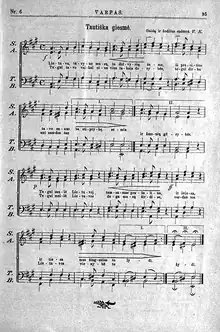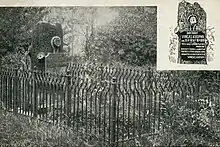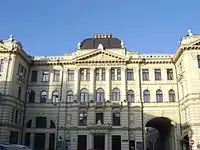| English: National Hymn | |
|---|---|
 | |
National anthem of Lithuania Former regional anthem of the Lithuanian SSR | |
| Also known as | Lietuva, Tėvyne mūsų (English: Lithuania, Our Homeland) Lietuvos himnas (English: Hymn of Lithuania) |
| Lyrics | Vincas Kudirka, November 13, 1898 |
| Music | Vincas Kudirka, 1898 |
| Published | 1899 |
| Adopted | 1919 1944 (by the Lithuanian SSR) |
| Readopted | 1988 |
| Relinquished | 1940 1950 (by the Lithuanian SSR) |
| Preceded by | Anthem of the Lithuanian Soviet Socialist Republic |
| Audio sample | |
U.S. Navy Band instrumental version
| |
"Tautiška giesmė" (pronounced [ˈtɐʊtʲɪʃkɐ ɡʲɪɛsʲˈmʲeː]; literally "The National Hymn") is the national anthem of Lithuania, also known by its opening words, "Lietuva, Tėvyne mūsų"[1][lower-alpha 1] (official translation of the lyrics:[3] "Lithuania, Our Homeland", literally: "Lithuania, Our Fatherland"), and as "Lietuvos himnas"[4] ("The National Anthem of Lithuania"). The music and lyrics were written in 1898 by Vincas Kudirka, when Lithuania was still part of the Russian Empire. The fifty-word poem was a condensation of Kudirka's conceptions of the Lithuanian state, the Lithuanian people, and their past. Shortly before his death in 1899, the anthem was performed for Lithuanians living in Saint Petersburg, Russia.
The first public Lithuanian performance of the anthem took place in Vilnius in 1905, and it became the official national anthem in 1919, a year after Lithuania declared its independence.
"Tautiška giesmė" was reinstated in 1989 shortly before the reestablishment of Lithuanian independence and confirmed in the National Anthem Act (21 October 1991). It was automatically included as the national anthem in 1992, when the new Constitution was ratified after independence from the Soviet Union was achieved. The status of "Tautiška giesmė" as the national anthem of Lithuania was further confirmed in 1999 with the passage of a national law stating this.
Creation


At the time when the poem Lietuva, Tėvyne mūsų was written, Lithuania was part of the Russian Empire. Kudirka, a medical student at the University of Warsaw, was writing as a columnist for the newspaper Varpas (The Bell). In his Varpas columns, Kudirka urged Lithuanians to take pride in their heritage, discussed the problems the Russian Government was causing the Lithuanian population, and denounced those who wished to work for the Tsarist autocracy. In the course of writing for Varpas, he wrote down his thoughts on what Lithuania was and what it should be, resulting in the fifty-word poem Lietuva, Tėvynė mūsų ("Lithuania, Our Homeland").[5]
The poem described the heroic past of Lithuania and exhorted its people to care for the land, care for humanity, and live in honor. Kudirka also urged the country to become a source of enlightenment and virtue. Without a melody, Kudirka took the time to compose the music just before dying of tuberculosis. Both the melody and the lyrics were printed in Varpas in September 1898. Upon his death in 1899, Kudirka's tomb was engraved with the second stanza of the anthem (later destroyed by the authorities).[6]
History

Pre-independent Lithuania
Before Kudirka's death, the first performance of the poem occurred at a concert in St. Petersburg, Russia in 1899. The concert was conducted by Česlovas Sasnauskas and was attended by Lithuanians, which St. Petersburg had the largest population of at that time. The anthem was first performed in Lithuania during the Great Seimas of Vilnius on December 3, 1905.
Independent Lithuania
When Lithuania declared its independence from Russia in 1918, the song was declared the national anthem.[7] It held this status until Lithuania was annexed into the Soviet Union during World War II.[8] During the interwar period, there had been suggestions to modify the words to include a reference to God. It was decided, in Kudirka's memory, that the lyrics should remain as he had written them.[9][10] Also, the national anthem received criticism over melody.
Usage in German-occupied Lithuania
From May 9th to 12th, 1942, the Marijampolė Commissariat took 580 young men as labour for the German Army Transportation Service. At the barracks, about 3000-4000 appeared, about two thirds of women and girls, and began to shout out: "We are not Germans, do not go to the front." At that time, about 70% of the troops returned to the barracks yard to support the demonstration as well as students from the Marijampole Teachers Seminary and the Marijamploe Gymnasium. The demonstrators sang Lithuanian liberation songs and Tautiška Giesmė. When threatened with a fight by several insufficiently armed local commando soldiers, the protest turned violent with members of the crowd breaking some windows. Finally, the crowd gathered on the street to walk to the city. In that direction, the soldiers of the Wehrmacht stoned the truck.
While singing the national anthem, the Lithuanian policemen paid homage, and weighed on two of them. The soldiers of the 1st Police Battalion in the Marijampolė were completely passive, with regard, to the crowd.[11]
Usage in the Lithuanian SSR
1940–1941

Immediately following the Soviet occupation of Lithuania, the government of the Lithuanian SSR published a new constitution, the Stalinist Constitution of the Lithuanian SSR, that regulates the usage of the new flag and the new coat of arms as a symbol of the socialist identity. However, in this constitution, there was no regulations on a regional anthem for the Lithuanian SSR. According to Soviet custom, all of the republics of the Soviet Union had the "Internationale" translated into their own language as regional anthems.[12]
The officially-introduced "Internationale" in Lithuania was unpopular and the majority of the population of Lithuania disliked it as most Lithuanians then still remembered the "Tautiška giesmė" as being their actual national anthem. This was particularly evident when the authorities gathered all of the teachers in 14–15 August 1940 at the Lithuanian Teachers' Congress in Kaunas. The congress was attended by more than 10,000 primary and secondary school teachers and high school lecturers. Of all the speakers, only the Prime Minister of Lithuania, Vincas Krėvė-Mickevičius, reminded the audience of the Lithuanian national anthem, concluding his speech: "Light and truth all along, guide our steps forever."[13] At the end of the congress the orchestra bagan playing the Internationale. A teacher began to sing the Tautiška Giesmė. Other teachers joined in singing the anthem, and shortly all of the teachers that attended the congress sang along, thus publicly testifying about "their determination to serve their homeland, but not the occupier". Inspired by them, the orchestra followed them standing.[14]
1944–1950


The issue about the anthem was raised again after the re-occupation of the Baltic States, after Lithuania re-joined the USSR as the Lithuanian SSR. A new anthem of the USSR was made, and the lyrics of the anthem were translated to the languages of the USSR republics. The original plan was to use the translated anthem as the temporary anthem, until a new, more socialist anthem was made.
During the translation process, Antanas Venclova as the translator, have some worries on the lyrics. The lyrics mentioned Великая Русь (English: Great Russia), which he translated to Didžiosios Rusios. He feared that the part of the lyrics would be badly accepted in Lithuania, because the lyrics shows superiority of the Russian nation in Lithuania, and the spirit of the national revival that passed away after the occupation of Lithuania. The translation of the anthem itself was submitted on 5 January 1944. The translation of the anthem was approved on 7 January 1944.[12]
On 26 January 1944, on the session of the Supreme Council of the USSR, the council adopted a resolution about the rights of all of the Soviet republics to hold their national military formations and Foreign Affairs Commissariat. The resolution was an attempt was made for the image of the USSR as the Soviet republics have an independent statehood. By doing so, the Soviet Union seeks to create a single place for each of the Soviet republics in the UN. Even before the session, Justas Paleckis proposed to the USSR Commissioner for Foreign Affairs of the People's Commissars, Vyacheslav Molotov, to consider whether the Soviet republics are allowed to have their own anthems. Molotov reported that the Politburo had decided to offer the Soviet republics to create their own anthems.[15]
With the offer from the USSR government, the question of the Lithuanian anthem was re-discussed. The first proposal of the anthem was the song "Mes su Stalinu" (English: We are with Stalin), which was proposed by G. Alexandrov to Kazys Preikšas. Other proposals proposed by G. Alexandrov was Tautiška giesmė, and other popular songs, including a poem by Petras Vaičiūnas "Ei, pasauli, mes be Vilniaus nenurimsime".[12]
On 1 June 1944 the Central Committee of the Communist Party of Lithuania prepared a draft resolution of the national anthem of Lithuania:
"At the present political situation, it is expedient to use the national anthem of Lithuania, in the Lithuanian SSR, to use its popularity and the opportunity to turn it into a weapon of strengthening the Soviet power to create a national anthem of the Lithuanian SSR..."[12]
The main points of the decree were:
- To allow the performance of music and text of the old Lithuanian national anthem, Tautiška giesmė, created in the end the 19th century by Vincas Kudirka as the National Anthem of the Lithuanian SSR
- To delay the question about the creation of the anthem of the Lithuanian until the time when it will be possible to attract all creative forces of the nation, and to create a hymn that reflects a new era in the life of the Lithuanian nation and the changes of the country's economy, culture and people's minds.[12]
In the same draft resolution, it was envisaged that the lyrics and the melody of the Tautiška giesmė will be approved by the Presidium of the Supreme Council of the Lithuanian SSR and the Presidium of the Supreme Soviet of the USSR.[12]
The question of the creation of a new anthem of the Lithuanian SSR returned a year later. From 28 until 29 September 1945, the issue was held at the meeting of the Lithuanian Communist Party Central Committee Bureau. In the meeting, it was decided that a new anthem of the Lithuanian SSR was needed to reflect the socio-political change in Lithuania. A commission was organized to make the new national anthem of the Lithuanian SSR.
The committee consisted of K. Preikšas as the chairman, Justas Paleckis, Juozas Banaitis, Juozas Žiugžda, and the honored artists in the Lithuanian SSR, Professor Juozas Gruodis, Kostas Korsakas, and Vladas Niunka. The lyrics and the melody of the national anthem of the Lithuanian SSR should be submitted no later than on 1 January 1946. However, the anthem wasn't submitted in the deadline. A new commission for the anthem was created, consisted of Antanas Venclova, Teofilis Tilvytis, Juozas Melnikas, Valerija Valsiūnienė, Eduardas Mieželaitis, Vacys Reimeris and Aleksys Churginas. Due to the active partisan struggle in Lithuania, the plans of the new national anthem was relinquished. Apparently, the authorities believed that replacing Tautiška giesmė with a new one would further aggravate dissatisfaction of the population with the political system.[12]
Of all the Soviet Baltic republics, only Lithuania could maintain the usage of their previous national anthem. The anthem was used until 1950. In Latvia and Estonia, new anthems were created and approved in 1945. Due to the different opinions about the anthem of the Lithuanian SSR, Justas Paleckis proposed to change the words of the Tautiška giesmė. However, the propose idea was rejected.[12]
1950
After decline in Lithuanian partisan activity, the authorities concluded that it was safe to introduce the new anthem. On July 15, 1950, in the 10th anniversary of the incorporation of Lithuania to the Soviet Union, the Presidium of the Supreme Council of the Lithuanian SSR approved a new anthem. The music for the anthem was composed by Balys Dvarionas and Jonas Švedas, and the words were written originally by Antanas Venclova. The anthem was confirmed in Article 169 of the 1978 Constitution of the Lithuanian SSR.[16]
1950–1988
Even though Tautiška giesmė was used as the national anthem of the Lithuanian SSR for 6 years, the anthem ended up being banned in the Lithuanian SSR after the introduction and the approvement as the new anthem. During this period, the Lithuanian Tautiška giesmė became a symbol of national resistance to the Soviet Union. The anthem was often sung at various festivities in families and in small gatherings of trusted people.
1988–1990
On 6 October 1988, Tautiška giesmė was approved as a replacement for the State Anthem of the Lithuanian SSR. The preliminary approval was made by the Supreme Soviet of the Lithuanian SSR and successive legislative bodies.
Current status
The status of Tautiška giesmė as the national anthem of the Lithuanian Republic was reconfirmed in 1992.[17] In that year, the Constitution of Lithuania was approved; Article 19 of the document states that Tautiška giesmė will be the national anthem of Lithuania.[18] The last law in relation to the national anthem was passed in 1999; it contained the official lyrics and protocol on how and when to play the anthem.[19]
1999 law
Signed into law by President Valdas Adamkus on 9 June 1999, the "Law on the National Anthem of the Republic of Lithuania" details when and where the national anthem is played and its performance protocols.[19]
Article 2 of the law states that the anthem is to be played at the following occasions: At the beginning or ending of solemn sessions of the Seimas, on national holidays and memorial days, and at receptions and farewells of foreign heads of state on official visits to Lithuania—but only after the anthem of the foreign country has been played.
It is played in foreign countries to represent Lithuania, according to their own diplomatic protocols; on national holidays and other days when the Flag of Lithuania is raised by order of the government; when the flag is raised during public events sponsored by governmental institutions, business, and organizations; and at the beginning and end of National Radio programming. The anthem may also be played at other occasions, such as sporting competitions.[19]
When playing the anthem, the music may be either live or recorded. The anthem may be performed with a choir, an orchestra, a military band, or a combination of the latter two. Article 4, section 2, states that all participants are encouraged to sing the national anthem. When the anthem is played, all civilians are asked to stand in a gesture of respect to the anthem. If employees of national defense, police, and other military or military-related organizations are present, they must respect the anthem in a way prescribed by their statutes. The anthem cannot be used as background music, purposes of advertisement, or for entertainment, such as karaoke. Public disrespect of the anthem may be punishable by law.[19]
Lyrics
| Lithuanian original[20][21][22] | IPA transcription[lower-alpha 2] | Official English translation[3] |
|---|---|---|
Lietuva, Tėvyne mūsų, |
[lʲiæ.tʊ.ˈvɐ | tʲeː.ˈvʲiː.nʲæ ˈmuː.suː |] |
Lithuania, our dear homeland, |
Sheet music
The Lithuanian National Culture Centre has created several sheet music for the anthem. Below are the sheet music for the anthem:
- Men's Choir (tenor and bass)
- Women's Choir (soprano and alto)
- Mixed Choir (soprano, alto, tenor and bass)
See also
Notes
- ↑ With Tėvyne sometimes uncapitalised.[2]
- ↑ See Help:IPA/Lithuanian and Lithuanian phonology.
- ↑ In the interwar period, Lietuvoj was written as Lietuvos (in the genitive rather than prepositional case).[23][24][25] The change to Lietuvoj was somewhat controversial,[26] and Lietuvos is sometimes still sung.[27][28][29][30][31][32]
- ↑ In the interwar period, tamsumas was written as tamsumus,[24][25][33] with the rare type IV masculine noun ending. Tamsumus is occasionally still sung.[27][28][29][32][34]
References
- ↑ ""Lietuva, Tėvyne mūsų…"– nuaidėjo per Pamario kraštą". Pamarys (in Lithuanian). 2020-07-10. Retrieved 2022-04-27.
- ↑ Turner, B. (2017-01-12). The Statesman's Yearbook 2011: The Politics, Cultures and Economies of the World. Springer. p. 801. ISBN 978-1-349-58635-6.
- 1 2 English Lyrics of Tautiška giesmė Seimas of the Republic of Lithuania - Retrieved 22 October 2007. Official translations are not copyrightable under the Lithuanian law.
- ↑ "Lietuvos audiovizualinio kultūros paveldo Išsaugojimo ir prieigos sistemos analizė ir plėtros rekomendacijos" (PDF). Ministry of Culture of the Republic of Lithuania. 2020-12-16. p. 80. Retrieved 2022-04-27.
- ↑ Poems by Vincas Kudirka Archived 2007-10-13 at the Wayback Machine members.efn.org - Retrieved 22 October 2007
- ↑ Vincas Kudirka biography from The Lithuanian Word - Published 1970–1978 as part of the ENCYCLOPEDIA LITUANICA. spaudos.lt - Retrieved 28 July 2007.
- ↑ Act of Independence of Lithuania (February 16, 1918) Archived November 2, 2007, at the Wayback Machine neris.mii.lt - Retrieved 22 October 2007
- ↑ Music and lyrics Archived 2007-08-13 at the Wayback Machine omnitel.net - Retrieved 22 October 2007
- ↑ Encyclopedia Lituanica, "National anthem", volume IV, pages 24-26
- ↑ Klimas, Antanas. Two Lithuanian Encyclopedias completed, Lituanus: Lithuanian Quarterly Journal of Arts and Sciences 25(4), Winter 1979. ISSN 0024-5089. lituanus.org - Retrieved 30 August 2006.
- ↑ Nacionalistų talka hitlerininkams, 1970, p. 91–92.
- 1 2 3 4 5 6 7 8 Marcinkevičius, Juozas (2005). "Tautiškos giesmės likimas prijungus Lietuvą prie Sovietų Sąjungos(1940-1950)". Lietuvos himnas (PDF). Vilnius: Lietuvos nacionalinis muziejus. ISBN 9955-415-23-1. Retrieved July 29, 2018.
- ↑ Years of Bolshevism. Kaunas, Lithuania: Archive of Lithuania.
- ↑ "Tautiška giesmė". Aidai. No. III. 1980. p. 148.
- ↑ Paleckis, Justas (1983). Dviejuose pasauliuose [Two worlds] (in Lithuanian).
- ↑ "Lietuvos TSR Konstitucijos" (in Lithuanian). 1978. Retrieved 2007-11-17.
- ↑ Books Extracts Archived 2007-10-27 at the Wayback Machine patogupirkti.lt - Retrieved 22 October 2007
- ↑ Constitution of the Republic of Lithuania: Chapter 1, Article 19
- 1 2 3 4 Law on the National Anthem of the Republic of Lithuania - Published 9 June 2007 Archived 28 September 2007 at the Wayback Machine skelbimas.lt - Retrieved 22 October 2007
- ↑ "Lietuvos valstybės himnas (Tautiška giesmė)". Office of the Government of the Republic of Lithuania (in Lithuanian). Retrieved 2022-02-02.
- ↑ "Lietuvos Respublikos valstybės himno įstatymas" [Law on the National Anthem of the Republic of Lithuania]. Seimas of the Republic of Lithuania (in Lithuanian). 1991-10-29. Retrieved 2022-02-02.
- ↑ "LR Konstitucija - 16 straipsnis ♫". Constitution of the Republic of Lithuania. Retrieved 2022-02-02.
- ↑ Urbonaitė-Vainienė, Ieva. "Tautiška giesmė kiršina lietuvius: kalta viena raidė". DELFI (in Lithuanian). Retrieved 2022-04-27.
- 1 2 Lithuanian National Foundation (U.S.) (2002). Tautos fondas: Lithuanian National Foundation, Inc., 1943-2002 (in Lithuanian). Lithuanian National Foundat. p. 15. ISBN 978-0-9718144-0-0.
- 1 2 Shaw, Martin (1975). National Anthems of the World. Blandford Press. p. 258. ISBN 978-0-7137-0679-6.
- ↑ Lithuanian Heritage (PDF). 5. Vol. 3. September–October 2015. pp. 19 (21 in file).
- 1 2 dss spakauskas (2009-07-06). "Lietuvos Himnas". YouTube. Archived from the original on 2022-04-28. Retrieved 2022-04-28.
- 1 2 Arunas Tirksliunas (2014-07-09). "Lietuvos Himnas - Lithanian Anthem sung in NYC 2014-July-6". YouTube. Archived from the original on 2022-04-28. Retrieved 2022-04-28.
- 1 2 Lietuviai prancuzijoje (2017-07-07). "Tautiška giesme, Paryžiuje 2017". YouTube. Archived from the original on 2022-04-28. Retrieved 2022-04-28.
- ↑ Lietuvos Respublikos Generalinis konsulatas Sankt Peterburge (2018-07-09). ""Tautiška giesmė" - Lietuvos Respublikos Generaliniame konsulate Sankt Peterburge". YouTube. Archived from the original on 2022-04-28. Retrieved 2022-04-28.
- ↑ KrepsinioReporteris (2011-09-09). "Tautiška giesmė". YouTube. Archived from the original on 2021-12-02. Retrieved 2022-04-28.
- 1 2 dss spakauskas (2013-03-16). "Lietuvos Himnas". YouTube. Archived from the original on 2022-04-28. Retrieved 2022-04-28.
- ↑ "Rokiškis Rabinovičius | Aš esu Rokiškis Rabinovičius ir būsiu Visatos Valdovas. Čia jums ne kokia vieša vieta, čia skirta tik tiems, kam aš leidau. - Part 120". Rokiškis Rabinovičius (in Lithuanian). Retrieved 2022-04-27.
- ↑ Naktinės Personos (2015-03-05). "Naktinės Personos - Lietuvos himnas (ft. M.Mikutavičius, I.Kofas, ŽAS)". YouTube. Archived from the original on 2022-04-28. Retrieved 2022-04-28.
External links
- Lietuvos valstybės himnas (Tautiška giesmė) Teksto ir muzikos autorius −Vincas Kudirka.
- Simbolika: Lietuvos valstybės himnas
- LIETUVOS VALSTYBĖS HIMNAS RINKINYS
- The Seimas of the Republic of Lithuania has a website with anthem lyrics and sheet music.
- Lithuania: Tautiška giesmė - Audio of the national anthem of Lithuania, with information and lyrics
- "A Virtual Exhibition of a Millennium of Lithuanian Cultural Heritage" - This exhibition website features a page about the anthem that includes a vocal sound file.
